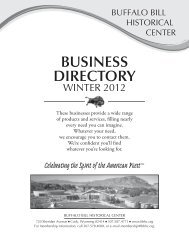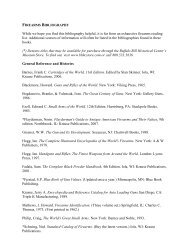BLM WY Golden Eagle Research and Monitoring - Buffalo Bill ...
BLM WY Golden Eagle Research and Monitoring - Buffalo Bill ...
BLM WY Golden Eagle Research and Monitoring - Buffalo Bill ...
Create successful ePaper yourself
Turn your PDF publications into a flip-book with our unique Google optimized e-Paper software.
latrans), red fox (Vulpes vulpes), <strong>and</strong> bobcat (Felis rufus). Occasionally, grizzly bears<br />
(Ursus arctos) w<strong>and</strong>er into the Basin, <strong>and</strong> cougars (Puma concolor) occur persistently in<br />
the area. Gray wolves (Canis lupus) range around <strong>and</strong> within the area, especially near<br />
livestock operations.<br />
Birds (seasonal or year-round residents) include greater sage-grouse<br />
(Centrocercus urophasianus), sage thrasher (Oreoscoptes montanus), Brewer’s sparrow<br />
(Spizella breweri), vesper sparrow (Pooecetes gramineus), lark bunting (Calamospiza<br />
melanocorys), western meadowlark (Sturnus neglecta), long-billed curlew (Numenius<br />
americanus), mountain plover (Charadrius montanus), golden (Aquila chrysaetos) <strong>and</strong><br />
American bald eagles (Haliaeetus leucocephalus), red-tailed (Buteo jamaicensis), roughlegged<br />
(B. lagopus), <strong>and</strong> Swainson’s hawks (B. swainsoni), prairie falcon (Falco<br />
mexicanus), great-horned (Bubo virginianus), long-eared (Asio otus), short-eared owls<br />
(Asio flammeus), <strong>and</strong> burrowing owls (Athene cunicularia). The Bighorn Basin is among<br />
the world’s remaining strongholds for greater sage-grouse populations (Harrell 2008).<br />
L<strong>and</strong> ownership in the Bighorn Basin is divided among private <strong>and</strong> public h<strong>and</strong>s,<br />
with the majority of public l<strong>and</strong> administered by the Bureau of L<strong>and</strong> Management. L<strong>and</strong><br />
use includes urban <strong>and</strong> exurban residential development, significant energy development,<br />
livestock grazing, <strong>and</strong> extensive motorized <strong>and</strong> non-motorized recreation. Additionally,<br />
the area is traversed by a maze of paved <strong>and</strong> unpaved transportation corridors. It is an<br />
increasingly popular area for hunting <strong>and</strong> other outdoor recreation. The Bighorn Basin is<br />
experiencing a period of rapid environmental change in response to weather fluctuations,<br />
increased recreational use, exurban residential sprawl, <strong>and</strong> significantly increased energy<br />
development, including the potential for wind energy development.<br />
7






